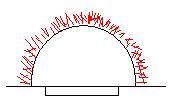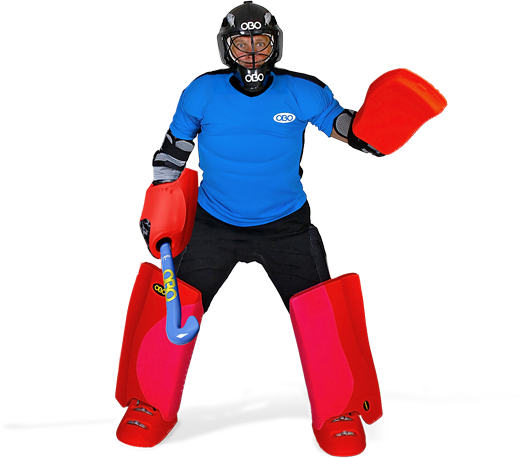KEEPERS RESOURCES

Shots outside the D
When a shot is taken outside the D and it is not touched by anyone within the D, then your team will get to restart play with a 16 (free hit from the 25). For example, a failed pass that has gone through your defence with no-one on the opposition to get on the end of it, or if and your defence has chosen to leave it (so that it can go off the pitch for a free hit). Instead of kicking it away, straight back into play, you can essentially ‘leave it’ to give your team a sixteen; the rules of the game mean that your team will restart the play after the ball has gone off the pitch.
Ball into the D untouched
Instead of stopping balls that make there way through the D without an opposition player touching the ball, you can leave it for a 16. The rules state that if an opposition player does not touch the ball inside the D, there is no connection, meaning that your team gets a free hit. Shots outside the D don’t count as goals. It is therefore a good idea to take advantage of this, to give you team control of the play; restarting play from a free hit. Learning to leave the ball in this way will benefit your team by giving them the chance to start breakouts, instead of giving the other team a chance to score from your mistakes.
Letting the ball past you
If a shot taken outside the D is untouched and does not get redirected within the D, then, your team will be able to restart the play from the sixteen. A sixteen will be given, so you can let the ball hit the backboard, with your team gaining a free hit. Therefore, if a shot is taken and there are no opposition players within the D with a chance of touching the ball, you can happily leave it and let it go off the pitch.

Tracking the ball
You need to track the ball all the way through until it is off the pitch; just like you watch and follow a shot into the save. In case you are not paying full attention and another player moves into the D when you weren’t looking, it is a good idea to keep an eye on the ball to make sure nothing goes wrong. Watch the ball’s path; tracking the ball to see if any other opposition player gets on the end of it, just in case, and also to ensure that it goes safely off the pitch without getting touched. Afterwards, go and collect the ball to give to your defender to restart the play from the sixteen.
Moving out the way
In order to successfully play the situation to make sure the ball goes off for a sixteen, you need to move out of its way. As you get more experienced and improve your technique, you can soon pick up the ability to ‘dummy’ any players by pretending to kick it; stepping out to “meet” the ball, before dodging its path, before letting it roll off the pitch, or into goal, without touching it. This way you fool the player and make sure it goes off at the same time.
- Move out the way: simply step or shuffle out of the ball’s path, which gives you the further option of being able to watch and track where it ends up
- Lift the appropriate leg up and out of the way;
- Jump out the way; jumping up and over the ball as
Pointers:
- Make sure you move out of the ball’s way
- If you do touch the ball, accidentally, then you need to kick it away, as the sixteen will no longer count because you (a player) have touched it.
Turning round
There is always a danger that the ball could hit the post and go back into play. By turning round, you can check that the ball does not hit the post and ‘stays safe’; ending up hitting the backboard. If it did hit the post, then you can easily get behind the ball to kick it away from danger, so that an attacking player can’t get to it. Act instantly and rush to get behind the ball (to block if needs be), or kick it away as far as possible to a safe area.
Rule of thumb
-
- If in doubt, kick it out!
Tips and deflections
There is still often the chance of a player running into the D and getting on the end of the pass to redirect it. If they get a touch on the ball, even the slimmest, and it goes past you, then it will still count as a goal. If you are worried about a goal being scored and can’t tell if , then you can follow the maxim of “kicking it out if in doubt”. If a deflection does occur then make sure you close off holes in your stance (i.e. bringing your legs together and bringing your gloves in to help cover) to block the ball.
Comments
Leave Your Comments Below
















































